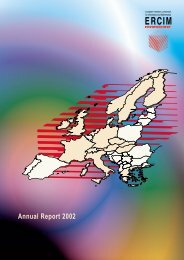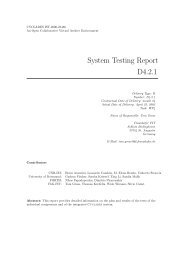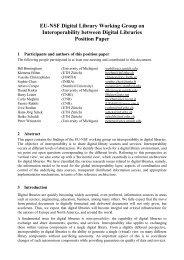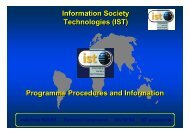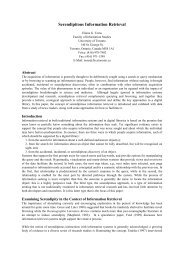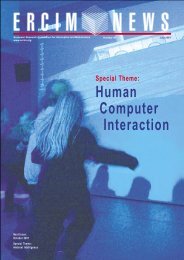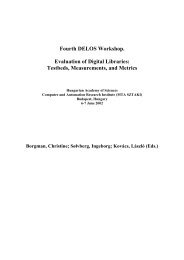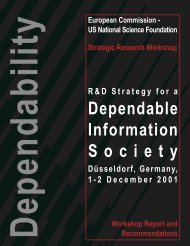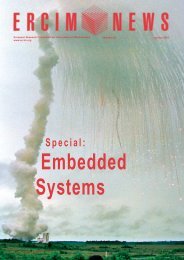Towards a Platform for Widespread Embedded Intelligence - ERCIM
Towards a Platform for Widespread Embedded Intelligence - ERCIM
Towards a Platform for Widespread Embedded Intelligence - ERCIM
You also want an ePaper? Increase the reach of your titles
YUMPU automatically turns print PDFs into web optimized ePapers that Google loves.
SPECIAL THEME: <strong>Embedded</strong> <strong>Intelligence</strong><br />
sions and a range of behaviours can give<br />
the robot a personality and which type of<br />
personality would be most appropriate<br />
during interaction with users <strong>for</strong> certain<br />
applications. Research with iCat has<br />
focused on the evaluation of application<br />
concepts <strong>for</strong> iCat, <strong>for</strong> example as a game<br />
buddy <strong>for</strong> children or as a TV assistant.<br />
The research questions in these studies<br />
were: “What personality do users<br />
prefer?” and “What level of control do<br />
they prefer?”<br />
The results of the user study with the<br />
iCat as game buddy indicated that children<br />
preferred to play games with the<br />
iCat rather than to play these same<br />
games with a computer. They were able<br />
to recognise differences in personalities<br />
between differently programmed versions<br />
of iCat. Overall, the more extrovert<br />
and sociable iCat was preferred to a<br />
more neutral personality.<br />
Young and middle-aged adults were also<br />
able to recognise differences in person-<br />
22 <strong>ERCIM</strong> News No. 67, October 2006<br />
ality in iCat as a TV assistant. In this<br />
study two personalities were combined<br />
with two levels of control. In the high<br />
control condition, iCat used a speechbased<br />
command-and-control interaction<br />
style, whereas in the low control condition<br />
it used a speech-based, system-initiated<br />
natural language dialogue style. The<br />
preferred combination was an extrovert<br />
and friendly personality with low usercontrol.<br />
One of the most interesting results was<br />
that the personality of the robot influenced<br />
the level of control that people<br />
perceived. This is very relevant in the<br />
context of intelligent systems that work<br />
autonomously to take tedious tasks out<br />
of the hands of humans. It suggests that<br />
the robot's personality can be used as a<br />
means to increase the amount of control<br />
that users perceive.<br />
Conclusion<br />
The studies with iCat have shown that<br />
mechanically-rendered emotions and<br />
The DECOS Tool-Chain: Model-Based<br />
Development of Distributed <strong>Embedded</strong><br />
Safety-Critical Real-Time Systems<br />
by Wolfgang Herzner, Bernhard Huber, György Csertan and Andras Balogh<br />
'Smart systems' applications like adaptive cruise control or brake-by-wire, rely<br />
on predictable and reliable embedded system plat<strong>for</strong>ms as infrastructure. For the<br />
development of such dependable applications, it is there<strong>for</strong>e of crucial interest<br />
to avoid faults during design and development. Besides intensive testing, an<br />
important way of minimising the risk of faults is by controlling the design and<br />
development process, as well as maximising the coherence of the resulting system<br />
with the initial requirements. The model-based tool-chain developed by the DECOS<br />
project is described.<br />
Today, the development of embedded -<br />
and in particular safety-critical - systems<br />
in general follows a customized design<br />
approach, resulting in rather isolated<br />
applications and little reuse of components<br />
and code across different application<br />
domains. For instance, in modern<br />
cars sub-systems like power-train control,<br />
advanced driver assistance systems<br />
or the body electronic co-exist, each<br />
equipped with its own electronic hardware,<br />
communication cabling etc. This<br />
approach implies at least increased hardware<br />
costs, weight, and power consumption,<br />
last not least due to severely hampering<br />
the sharing of resources like sensors<br />
among the different sub-systems.<br />
There<strong>for</strong>e, the European project DECOS<br />
aims at developing basic enabling technology<br />
<strong>for</strong> moving from federated to<br />
integrated distributed architectures in<br />
order to reduce development, validation<br />
and maintenance costs, and increase the<br />
behaviours can have a significant effect<br />
on the way users perceive – and interact<br />
with – robots. Moreover, users prefer to<br />
interact with a socially-intelligent robot<br />
<strong>for</strong> a range of applications, compared to<br />
more conventional interaction means. A<br />
range of further studies is planned. One<br />
of the questions that will be addressed is<br />
how iCat should behave to inspire trust<br />
and compliance in users, important if<br />
one thinks of the robot cat as a personal<br />
(health) trainer, <strong>for</strong> example.<br />
Links:<br />
http://www.hitech-projects.com/icat<br />
Please contact:<br />
Bernt Meerbeek, Philips Research Europe,<br />
The Netherlands<br />
Tel: +31 40 27 47535<br />
E-mail: bernt.meerbeek@philips.com<br />
Albert van Breemen, Philips Research<br />
Europe, The Netherlands<br />
Tel: +31 40 27 47864<br />
E-mail: albert.van.breemen@philips.com<br />
dependability of embedded applications<br />
in various application domains.<br />
'Integrated' means, that several software<br />
'IP'-blocks (Intellectual Property) of different<br />
criticality can be allocated to one<br />
node (ECU – Electronic Control Unit)<br />
without interfering with each other, ie,<br />
guaranteed encapsulation in space<br />
(memory) and time (each job has its<br />
reserved time slot).<br />
DECOS presumes the existence of a core<br />
architecture providing the core services:<br />
• deterministic and timely message<br />
transport<br />
• fault tolerant clock synchronisation<br />
• strong fault isolation<br />
• consistent diagnosis of failing nodes.<br />
Any core architecture providing these<br />
services (eg TTP/C, FlexRay, or Time-



